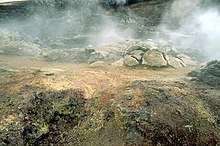Outgassing
Under gassing refers to the escape of gases from liquid or solid material . This can be due to pressure relief , temperature increase or other processes such as bacterial or chemical conversion.
Outgassing is a common occurrence in nature. Technically, it can be both desired, for example when adhesive bonds harden, but also undesirable, for example in landfill facilities . If the gases are specifically removed by a technical process, one usually speaks of degassing .
Physical basics
Outgassing occurs most strongly with warming liquids in connection with a pressure reduction and is determined here by the solubility of the gases. According to Henry's law, this decreases with decreasing partial pressure and increasing temperatures. A form of outgassing known from everyday life is the foaming when opening a carbonated mineral water bottle.
In the case of solids, the gas particles must first diffuse to the surface and then desorb from there , which is why outgassing from solids takes much longer than from liquids. The rate of gas release increases exponentially as the temperature rises.
Pores , created in a natural ( pumice stone ) or artificial ( foam ) way, simplify the gas release.
Outgassing through volcanism

A clear example is the outgassing of solidifying lava from volcanoes , especially in the highly viscous forms ( ʻAʻā lava ) of the Indian and Pacific volcanic islands . You can usually smell the outgassing of sulphurous substances.
When magma rises through a volcanic chimney , there is also such a strong outgassing due to pressure relief that carried along rock debris is accelerated up to supersonic speed.
Certainly a part of is origin of water on earth by water vapor explained that in the course of geological history of the Earth's interior is hospitable. A larger part is likely to come from earlier impacts by comets , meteors and asteroids from the more distant areas of the solar system . Many carbonaceous chondrites in the outer asteroid belt have a water or ice content of more than 10% of their mass.
Outgassing as an astrophysical phenomenon
A well-known example of outgassing are the nuclei of tail-forming comets when they are heated by solar radiation in the orbit sections of their elongated ellipses near the sun . With this approach, almost each of these "dirty snowballs " made of rock and ice releases various gases and also fine dust to its surface, which envelop the rock core as a luminous coma or envelope and are "blown" into space as a thin comet tail by the solar wind or radiation pressure .
Most of the Transneptunes also contain water and other ice that turns into water vapor or other gas if the path changes towards the sun or if there is a major meteorite impact .
Medical phenomenon
A sudden drop in pressure on the human body, for example if a diver ascends too quickly , can lead to the formation of blisters in the blood with severe medical consequences, known as diving disease .
Outgassing in technology
In nuclear technology , the problem of gases in the repository of radioactive waste has been known for a long time.
In technology and the home, it is important to avoid the emission of toxic substances, for example from paint , wall and floor coverings , treated wood or textiles . In the 1990s it was discovered that materials containing formaldehyde , for example in impregnated wood-based materials, outgas harmful substances. Certain urea compounds can also release formaldehyde into the ambient air for years.
In order to avoid contamination of the air in closed rooms by pollutants , many production methods have been changed, for example for furniture , paint, adhesives and wall coverings. It was possible to reduce the pollutants released in tiling and sealing by up to 90%.
However, there are no building materials that can do completely without emissions . Also upholstered furniture or mattresses made of natural products such as coconut or wool can outgas toxic pesticides. On the other hand, coatings with oils , waxes or alkalis also release organic solvents such as terpenes , but these do not have to be harmful.
In vacuum technology , outgassing from the materials used is a problem, since gas flowing into the vacuum again leads to a pressure increase and limits the vacuum that can be achieved (so-called virtual leak ).
Individual evidence
- ↑ a b Karl Jousten u. a .: Wutz manual vacuum technology . Ed .: Karl Jousten. 10th edition. Vieweg + Teubner, Wiesbaden 2010, ISBN 978-3-8348-0695-6 , chap. 6.1. Sorption phenomena and their meaning - terms and terminology, p. 202–204 ( limited preview in Google Book search).
- ↑ a b c Chr. Edelmann: Gas delivery . In: Manfred von Ardenne u. a. (Ed.): Effects of physics and their applications . 3. Edition. Harri Deutsch Verlag, Frankfurt am Main 2005, ISBN 3-8171-1682-9 , p. 320 f . ( limited preview in Google Book search).